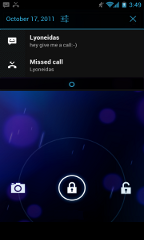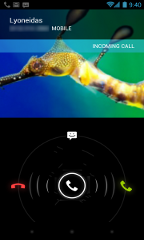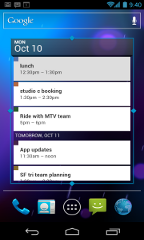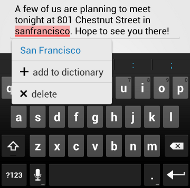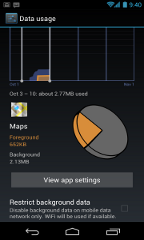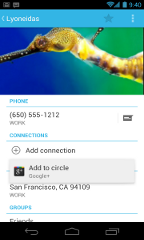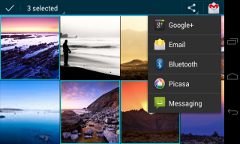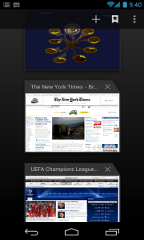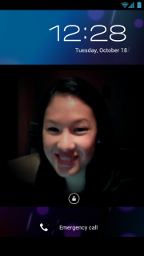Thanks to edgar86 from AndroidPT
Everything you need for Optimus Boston and clones (Orange Boston, Gsmart G1305, XT502, Apanda A60, Vibo A688, Excalibur, A1, A88, Z71, Blaze, Journey, F911)
Oct 29, 2011
[Rom 2.3] EA#20 Kernel
Etiquetas:
A60,
battery fix,
Boston,
cyanogen mod 7,
EA#11,
Final,
gapps,
Kernel,
memory,
memory fix,
nb0,
rom 2.3.5,
Stable,
SuperAOSP 8,
XT502,
z71
Oct 26, 2011
[Rom 2.3.7] MyGingerB 1.0.3 stable

Likes:
Fluid performance – didn’t notice any lag
Default Gingerbread launcher – fast and lovely!
Better memory management – features RAM optimizer from juwe11
Great battery life (with the Ubuntu kernel)
Nice splash-screen animation – won’t hurt your eyes
No illegal reboots
Camera is slightly, but noticeably faster than stock CM7.1
Quad score @600 MHz on-demand – 898
Quad score @672 MHz on-demand – 1004
Issues:
Wi-Fi performance was not as expected – was expecting it to be better than the stock CyanogenMod version. May be it’s just my phone!
Volume rocker wake is missing (I use it a lot) – because it’s primarily designed for Spice MI 300?
Signal fluctuations when on 3G – over optimized for Malaysian networks?
So, it’s time to install this ROM on your phone…
Download: MyGingerb-1.0.3stable-signed.zip
- Thanks to all who encourage me in Lowyat.net, even I am new here
- SuperAOSP team
- Cyanogenmod Team
- AndroidPT team
- CSL, for this very amazing phone. (I want a job there if I can)
Malaysian developer FTW
Etiquetas:
A60,
battery fix,
Boston,
cyanogen mod 7,
Final,
gapps,
memory,
memory fix,
mygingerb,
nb0,
rom 2.3.5,
Stable,
SuperAOSP 8,
XT502,
z71
[Rom 2.3] EA#11 Kernel
Etiquetas:
A60,
battery fix,
Boston,
cyanogen mod 7,
EA#11,
Final,
gapps,
Kernel,
memory,
memory fix,
nb0,
rom 2.3.5,
Stable,
SuperAOSP 8,
XT502,
z71
Oct 24, 2011
[Rom 2.3.7] Cyanogen MOD 7 build 235
CyanogenMOD 7 for Commtiva Z71, Apanda A60, Chinavision Excalibur, Cincinnati Bell Blaze, Gigabyte Gsmart G1305, Motorola XT502, Muchtel A1, Optimus Boston, Orange Boston, Spice Mi-300, Vibo A688 and Wellcom A88 - official nightly version
Visit the CHANGELOG for a full list of changes and features!"
Nightly version after the last Stable:
Download: cm_z71_full-235.zip
Google Apps: gapps-gb-20110828-signed.zip
Thank you to EVERYONE involved in Cyanogen! Enjoy!
Visit the CHANGELOG for a full list of changes and features!"
Nightly version after the last Stable:
Download: cm_z71_full-235.zip
Google Apps: gapps-gb-20110828-signed.zip
Thank you to EVERYONE involved in Cyanogen! Enjoy!
Etiquetas:
A60,
battery fix,
Boston,
cyanogen mod 7,
Final,
gapps,
memory,
memory fix,
nb0,
rom 2.3.5,
Stable,
SuperAOSP 8,
XT502,
z71
[Rom 2.3.7] Cyanogenmod 7.1 aPT v1
ROM:
Cyanogen 7.1
Android 2.3.7
Goggle Apps 28/08/2011
Clockwork Recovery 5.0.2.6
Simple2ext (s2e)
Screenshots:




Changelog:
- Splash Logo Google
- Google Nexus Prime Boot Animation
- Flash Player 10.2
- Added option to wake phone with front keys
- AR6002 WiFi Firmware updated
- Firmware updated GPU Adreno 200 (RGBX_8888 enabled)
- Performace 3D increased, especially with overclocking
- Overclocking System completely changed, should bring better results for those who could not overclock for certain frequencies.
- Number of available frequencies overclocking from 480MHz (604, 614, 633, 652, 672, 691, 710, 729, 748, 768, 787, 806, 825, 844, 864)
- Kernel version with optional AHB-bus overclock by 50% (memory speed)
- Config changed to use GPS NTP server of Portugal (pt.pool.ntp.org), faster response speed
- Lowmemorykiller aggressive to free RAM
- TCP buffer size tweaks
- Several tweaks build prop
- USB transfer speed increased (confirmation?)
- Power Profile updated (battery consumption statistics more accurate, allowing you to see the wakelocks consuming battery)
- Removed option to reboot into the bootloader
- Added option to disable bootanimation (boot faster)
- Gallery3D graphics changed to the correct (was using low-resolution images, just see the camera button)
- Added option to choose for the battery icon and remove too.
- Ring lockscreen graphics changed
- Added option to choose the preferred network (GSM only, GSM / WCDMA auto, etc.)
- Fixed bug ringtone or notification does not touch the speaker when the headphones are connected (now plays in the second when activated in the options)
- Changed the Gallery3D to maintain the same level of brightness the camera app (when it would take a picture and we would see the result in the gallery, the light sensor reduced the brightness depending on the conditions and the result was never the same as we had seen in the preview)
- BusyBox 1.19.2
- Some changes will bionic / Dalvik libstagefright and small bugs.
Download: update-cm-7.1.0-aPT-v1a.zip Thanks to Fagulhas from AndroidPT
Screenshots:




Changelog:
- Splash Logo Google
- Google Nexus Prime Boot Animation
- Flash Player 10.2
- Added option to wake phone with front keys
- AR6002 WiFi Firmware updated
- Firmware updated GPU Adreno 200 (RGBX_8888 enabled)
- Performace 3D increased, especially with overclocking
- Overclocking System completely changed, should bring better results for those who could not overclock for certain frequencies.
- Number of available frequencies overclocking from 480MHz (604, 614, 633, 652, 672, 691, 710, 729, 748, 768, 787, 806, 825, 844, 864)
- Kernel version with optional AHB-bus overclock by 50% (memory speed)
- Config changed to use GPS NTP server of Portugal (pt.pool.ntp.org), faster response speed
- Lowmemorykiller aggressive to free RAM
- TCP buffer size tweaks
- Several tweaks build prop
- USB transfer speed increased (confirmation?)
- Power Profile updated (battery consumption statistics more accurate, allowing you to see the wakelocks consuming battery)
- Removed option to reboot into the bootloader
- Added option to disable bootanimation (boot faster)
- Gallery3D graphics changed to the correct (was using low-resolution images, just see the camera button)
- Added option to choose for the battery icon and remove too.
- Ring lockscreen graphics changed
- Added option to choose the preferred network (GSM only, GSM / WCDMA auto, etc.)
- Fixed bug ringtone or notification does not touch the speaker when the headphones are connected (now plays in the second when activated in the options)
- Changed the Gallery3D to maintain the same level of brightness the camera app (when it would take a picture and we would see the result in the gallery, the light sensor reduced the brightness depending on the conditions and the result was never the same as we had seen in the preview)
- BusyBox 1.19.2
- Some changes will bionic / Dalvik libstagefright and small bugs.
Download: update-cm-7.1.0-aPT-v1a.zip Thanks to Fagulhas from AndroidPT
Etiquetas:
A60,
battery fix,
Boston,
Commtiva Z71,
cyanogen mod 7,
Final,
gapps,
memory,
memory fix,
nb0,
rom 2.3.5,
Stable,
SuperAOSP 8,
XT502
Oct 19, 2011
[Rom 4] Android Ice Cream Sandwich
Simple, beautiful, beyond smart
Android 4.0 builds on the things people love most about Android — easy multitasking, rich notifications, customizable home screens, resizable widgets, and deep interactivity — and adds powerful new ways of communicating and sharing.
Refined, evolved UI
Focused on bringing the power of Android to the surface, Android 4.0 makes common actions more visibleand lets users navigate with simple, intuitive gestures. Refined animations and feedback throughout the system make interactions engaging and interesting. An entirely new typeface optimized for high-resolution screens improves readability and brings a polished, modern feel to the user interface.
Virtual buttons in the System Bar let users navigate instantly to Back, Home, and Recent Apps. The System Bar and virtual buttons are present across all apps, but can be dimmed by applications for full-screen viewing. Users can access each application's contextual options in the Action Bar, displayed at the top (and sometimes also at the bottom) of the screen.
Multitasking is a key strength of Android and it's made even easier and more visual on Android 4.0. The Recent Apps button lets users jump instantly from one task to another using the list in the System Bar. The list pops up to show thumbnail images of apps used recently — tapping a thumbnail switches to the app.
Rich and interactive notifications let users keep in constant touch with incoming messages, play music tracks, see real-time updates from apps, and much more. On smaller-screen devices, notifications appear at the top of the screen, while on larger-screen devices they appear in the System Bar.
Home screen folders and favorites tray
New home screen folders offer a new way for users to group their apps and shortcuts logically, just by dragging one onto another. From the All Apps launcher, users can now simply drag an app to get information about it or immediately uninstall it, or disable a pre-installed app.
On smaller-screen devices, the home screen now includes a customizablefavorites tray visible from all home screens. Users can drag apps, shortcuts, folders, and other priority items in or out of the favorites tray for instant access from any home screen.
Resizable widgets
Home screens in Android 4.0 are designed to be content-rich and customizable. Users can do much more than add shortcuts — they can embed live application content directly through interactive widgets. Widgets let users check email, flip through a calendar, play music, check social streams, and more — right from the home screen, without having to launch apps. Widgets are resizable, so users can expand them to show more content or shrink them to save space.
New lock screen actions
The lock screens now let users do more without unlocking. From the slide lock screen, users can jump directly to the camera for a picture orpull down the notifications window to check for messages. When listening to music, users can even manage music tracks and see album art.
Quick responses for incoming calls
When an incoming call arrives, users can now quickly respond by text message, without needing to pick up the call or unlock the device. On the incoming call screen, users simply slide a control to see a list of text responses and then tap to send and end the call. Users can add their own responses and manage the list from the Settings app.
Swipe to dismiss notifications, tasks, and browser tabs
Android 4.0 makes managing notifications, recent apps, and browoser tabs even easier. Users can now dismiss individual notifications, apps from the Recent Apps list, and browser tabs lists with a simple swipe of a finger.
Improved text input and spell-checking
The soft keyboard in Android 4.0 makes text input even faster and more accurate. Error correction and word suggestion are improved through a new set of default dictionaries and more accurate heuristics for handling cases such as double-typed characters, skipped letters, and omitted spaces. Word suggestion is also improved and the suggestion strip is simplified to show only three words at a time.
To fix misspelled words more easily, Android 4.0 adds a spell-checker that locates and underlines errors and suggests replacement words. With one tap, users can choose from multiple spelling suggestions, delete a word, or add it to the dictionary. Users can even tap to see replacement suggestions for words that are spelled correctly. For specialized features or additional languages, users can now download and install third-party dictionaries, spell-checkers, and other text services.
Powerful voice input engine
Android 4.0 introduces a powerful new voice input engine that offers a continuous "open microphone" experience and streaming voice recognition. The new voice input engine lets users dictate the text they want, for as long as they want, using the language they want. Users can speak continously for a prolonged time, even pausing for intervals if needed, and dictate punctuation to create correct sentences. As the voice input engine enters text, it underlines possible dictation errors in gray. After dictating, users can tap the underlined words to quickly replace them from a list of suggestions.
Control over network data
Mobile devices can make extensive use of network data for streaming content, synchronizing data, downloading apps, and more. To meet the needs of users with tiered or metered data plans, Android 4.0 adds new controls for managing network data usage.
In the Settings app, colorful charts show the total data usage on each network type (mobile or Wi-Fi), as well as amount of data used by each running application. Based on their data plans, users can optionally set warning levels or hard limits on data usage or disable mobile data altogether. Users can also manage the background data used by individual applications as needed.
Designed for accessibility
A variety of new features greatly enhance the accessibility of Android 4.0 for blind or visually impaired users. Most important is a new explore-by-touch mode that lets users navigate without having to see the screen. Touching the screen once triggers audible feedback that identifies the UI component below; a second touch in the same component activates it with a full touch event. The new mode is especially important to support users on new devices that use virtual buttons in the System Bar, rather than dedicated hardware buttons or trackballs. Also, standard apps are updated to offer an improved accessibility experience. The Browser supports a script-based screen reader for reading favorite web content and navigating sites. For improved readability, users can also increase the default font size used across the system.
The accessibility experience begins at first setup — a simple touch gesture during setup (clockwise square from upper left) activates all accessibility features and loads a setup tutorial. Once accessibility features are active, everything visible on the screen can be spoken aloud by the standard screen reader.
Communication and sharing
Designed for the way people live, Android 4.0 integrates rich social communication and sharing touchpoints across the system, making it easy to talk, email, text, and share.
People and profiles
Throughout the system, a user’s social groups, profiles, and contacts are linked together and integrated for easy accessibility. At the center is a new People app that offers richer profile information, including a large profile picture, phone numbers, addresses and accounts, status updates, and a new button for connecting on integrated social networks.
The user's own contact information is stored in a new "Me" profile, allowing easier sharing with apps and people. All of the user's integrated contacts are displayed in an easy to manage list, including controls over which contacts are shown from any integrated account or social network. Wherever the user navigates across the system, tapping a profile photo displays Quick Contacts, with shortcuts to phone numbers, text messaging, and more.
Unified calendar, visual voicemail
To help organize appointments and events, an updated Calendar app brings together personal, work, school, and social agendas. With user permission, other applications can contribute events to the calendar and manage reminders, for an integrated view across multiple calendar providers. The app is redesigned to let users manage events more easily. Calendars are color-coded and users can swipe left or right to change dates and pinch to zoom in or out agendas.
In the phone app, a new visual voicemail features integrates incoming messages, voice transcriptions, and audio files from one or more providers. Third-party applications can integrate with the Phone app to add their own voice messages, transcriptions, and more to the visual voicemail inbox.
Rich and versatile camera capabilities
The Camera app includes many new features let users capture special moments with great photos and videos. After capturing images, they can edit and share them easily with friemds.
When taking pictures, continuous focus, zero shutter lag exposure, and decreased shot-to-shot speed help capture clear, precise images. Stabilized image zoom lets users compose photos and video in the way they want, including while video is recording. For new flexibility and convenience while shooting video, users can now take snapshots at full video resolution just by tapping the screen as video continues to record.
To make it easier to take great pictures of people, built-in face detection locates faces in the frame and automatically sets focus. For more control, users can tap to focus anywhere in the preview image.
For capturing larger scenes, the Camera introduces a single-motion panorama mode. In this mode, the user starts an exposure and then slowly turns the Camera to encompass as wide a perspective as needed. The Camera assembles the full range of continuous imagery into a single panoramic photo.
After taking a picture or video, users can quickly share it by email, text message, bluetooth, social networks, and more, just by tapping the thumbnail in the camera controls.

A Photo Gallery widget on the home screen.
Redesigned Gallery app with photo editor
The Gallery app now makes it easier to manage, show, and share photos and videos. For managing collections, a redesigned album layout shows many more albums and offers larger thumbnails. There are many ways to sort albums, including by time, location, people, and tags. To help pictures look their best, the Gallery now includes a powerful photo editor. Users can crop and rotate pictures, set levels, remove red eyes, add effects, and much more. After retouching, users can select one or multiple pictures or videos to share instantly over email, text messaging, bluetooth, social networks, or other apps.
An improved Picture Gallery widget lets users look at pictures directly on their home screen. The widget can display pictures from a selected album, shuffle pictures from all albums, or show a single image. After adding the widget to the home screen, users can flick through the photo stacks to locate the image they want, then tap to load it in Gallery.

Live Effects let you change backgrounds and use Silly Faces during video.
Live Effects for transforming video
Live Effects is a collection of graphical transformations that add interest and fun to videos captured in the Camera app. For example, users can change the background behind them to any stock or custom image, for just the right setting when shooting video or using Google Talk video chat. Also available is Silly Faces, a set of morphing effects that use state-of-the-art face recognition and GPU filters to add great effects facial features during video capture. For example, you can use effects such as small eyes, big mouth, big nose, face squeeze, and more. Outside of the Camera app, Live Effects is available during video chat in the Google Talk app.
Sharing with screenshots
Users can now share what's on their screens more easily by taking screenshots. Hardware buttons let them snap a screenshot and store it locally. Afterward, they can view, edit, and share the screen shot in Gallery or a similar app.
Cloud-connected experience
Android has always been cloud-connected, letting users browse the web and sync photos, apps, games, email, and contacts — wherever they are and across all of their devices. Android 4.0 adds new browsing and email capabilities to let users take even more with them and keep communication organized.
Powerful web browsing
The Android Browser offers an experience that’s as rich and convenient as a desktop browser. It lets users instantly and manage sync Google Chrome bookmarks from all of their accounts, jump to their favorite content faster, and even save it for reading later in case there's no network available.
To get the most out of web content, users can now request full desktop versions of web sites, rather than their mobile versions. Users can set their preference for web sites separately for each browser tab. For longer content, users can save a copy for offline reading. To find and open saved pages, users can browse a visual list that’s included with browser bookmarks and history. For better readability and accessibility, users can increase the browser’s zoom levels and override the system default text sizes.
Across all types of content, the Android Browser offers dramatically improved page rendering performancethrough updated versions of the WebKit core and the V8 Crankshaft compilation engine for JavaScript. In benchmarks run on a Nexus S device, the Android 4.0 browser showed an improvement of nearly 220% over the Android 2.3 browser in the V8 Benchmark Suite and more than 35% in the SunSpider 9.1 JavaScript Benchmark. When run on a Galaxy Nexus device, the Android 4.0 browser showed improvement of nearly 550% in the V8 benchmark and nearly 70% in the SunSpider benchmark.
Improved email
In Android 4.0, email is easier to send, read, and manage. For composing email, improved auto-completion of recipients helps with finding and adding frequent contacts more quickly. For easier input of frequent text, users can now create quick responses and store them in the app, then enter them from a convenient menu when composing. When replying to a message, users can now toggle the message to Reply All and Forward without changing screens.
For easier browsing across accounts and labels, the app adds an integrated menu of accounts and recent labels. To help users locate and organize IMAP and Exchange email, the Email app now supports nested mail subfolders, each with synchronization rules. Users can also search across folders on the server, for faster results.
For enterprises, the Email app supports EAS v14. It supports EAS certificate authentication, provides ABQ strings for device type and mode, and allows automatic sync to be disabled while roaming. Administrators can also limit attachment size or disable attachments.
For keeping track of incoming email more easily, a resizable Email widget lets users flick through recent email right from the home screen, then jump into the Email app to compose or reply.
Innovation
Android is continously driving innovation forward, pushing the boundaries of communication and sharing with new capabilities and interactions.
Android Beam for NFC-based sharing
Android Beam is an innovative, convenient feature for sharing across two NFC-enabled devices, It lets people instantly exchange favorite apps, contacts, music, videos — almost anything. It’s incredibly simple and convenient to use — there’s no menu to open, application to launch, or pairing needed. Just touch one Android-powered phone to another, then tap to send.
For sharing apps, Android Beam pushes a link to the app's details page in Android Market. On the other device, the Market app launches and loads the details page, for easy downloading of the app. Individual apps can build on Android Beam to add other types of interactions, such as passing game scores, initiating a multiplayer game or chat, and more.
Face Unlock
Android 4.0 introduces a completely new approach to securing a device, making it even more personal — Face Unlock is a new screen-lock option that lets users unlock their devices with their faces. It takes advantage of state-of-the-art facial recognition technology to register a face and to recognize it later when unlocking the device. Users just hold their devices in front of their faces to unlock, or use a backup PIN or pattern.
Wi-Fi Direct and Bluetooth HDP
Support for Wi-Fi Direct lets users connect directly to nearby peer devices over Wi-Fi, for more reliable, higher-speed communication. No internet connection or tethering is needed. Through third-party apps, users can connect to compatible devices to take advantage of new features such as instant sharing of files, photos, or other media; streaming video or audio from another device; or connecting to compatible printers or other devices.
Android 4.0 also introduces built-in support for connecting to Bluetooth Health Device Profile (HDP) devices. With support from third-party apps, users can connect to wireless medical devices and sensors in hospitals, fitness centers, homes, and elsewhere. In addition, for connecting to higher quality Bluetooth audio devices, Android 4.0 adds support for Bluetooth Hands Free Profile (HFP) 1.6.
Etiquetas:
Android Ice Cream Sandwich,
Boston,
Rom 4
[Rom 2.3.7] Cyanogen MOD 7 build 230
CyanogenMOD 7 for Commtiva Z71, Apanda A60, Chinavision Excalibur, Cincinnati Bell Blaze, Gigabyte Gsmart G1305, Motorola XT502, Muchtel A1, Optimus Boston, Orange Boston, Spice Mi-300, Vibo A688 and Wellcom A88 - official nightly version
Visit the CHANGELOG for a full list of changes and features!"
Nightly version after the last Stable:
Download: cm_z71_full-230.zip
Google Apps: gapps-gb-20110828-signed.zip
Thank you to EVERYONE involved in Cyanogen! Enjoy!
Visit the CHANGELOG for a full list of changes and features!"
Nightly version after the last Stable:
Download: cm_z71_full-230.zip
Google Apps: gapps-gb-20110828-signed.zip
Thank you to EVERYONE involved in Cyanogen! Enjoy!
Etiquetas:
A60,
battery fix,
Boston,
cyanogen mod 7,
Final,
gapps,
memory,
memory fix,
nb0,
rom 2.3.5,
Stable,
SuperAOSP 8,
XT502,
z71
Oct 10, 2011
[ROM 2.3.7] CyanogenMOD 7.1 STABLE
Changelog:
Common: Android 2.3.7 (Google)
Common: Bluetooth mouse support - Scott Brady
Common: Improve notification swipe-to-clear - Evan Charlton
Common: Improve album-artist support in media scanner - Paul Crovella
Common: Profile improvements and bugfixes - Martin Long, Danny Baumann, Robert Burns
Common: RTL text improvements - Eyad Aboulouz, Eran Mizrahi
Common: Wake on volume key option - Sven Dawitz
Common: Support for revoking application permissions - Plamen K. Kosseff
Common: Latest Superuser app - ChainsDD
Common: Control brightness by sliding on statusbar - Danesh M
Common: Add "copy all" to context menu - Danesh M
Common: Lockscreen haptic and statusbar indicators toggle - Danesh M
Common: Nicer timepicker/datepicker - Jiri Tyr
Common: Configuration 0/90/180/270 rotation - Jonas Larsson, Scott Brady
Common: DSP Manager bugfixes and improvements - Antti S Lankila
Common: Support for launching apps via gestures in the background - Jiri Tyr
Common: Option to hide hold button during call - Roberto Leinardi
Common: Allow using wildcards for call blacklisting - Nihanth Subramanya
Common: Option to allow in-call lockscreen to match main lockscren - Sven Dawitz
Common: Option to notify about incoming call only in background when screen is on - Pavel Kucera
Common: ADWLauncher- Transitions, catalog improvements, bugfixes - John Van Etten
Common: Optional GMT correction for SMS/MMS timestamps - Terry Hau
Common: Add FM Seek for TI devices - KalimochoAz
Common: Add FM support for SI4708 devices (Blade, V9, Racer) - Stéphane Konstantaropoulos
Common: Add FM seek implementation to FM application - Tom Giordano
Common: Show current FM status on lockscreen - Tom Giordano
Common: Camera touch-to-focus - cyanogen, arcee, m0viefreak, Danny Baumann
Common: Screenshot feature via power menu - arcee
Common: WEBP backport - Vikas Arora
Common: Add CM copyright noticies - arcee
Common: Skia/Zlib/libcore ARM optimizations - 0xlab
Common: Bluetooth tethering - Stéphane Konstantaropoulos
Common: Lockscreen widget alignment - Danesh Mondegarian
Common: Lockscreen calendar - David Morgan
Common: AVRCP 1.3 support - Qualcomm (bugfix by Danny Baumann)
Common: LED notification overhaul - Danny Baumann
Common: System-wide DNS cache - Google, SEMC
Common: Headset icon toggle - Cameron Pickett
Common: FM seek support - Emilio López, Tom Giordano
Common: Editable event fields in Contacts app - Danny Baumann
Common: Remove compromised CA from system certs - Guardian Project
Common: Mute camera shutter option - George Maizel
Common: Camera timer - Danesh Mondegarian
Common: "Mark all read" option in MMS - Vinod Surendran
Common: "eat" pushes fresh brunch/breakfast to device - Ricardo Cerqueira
Common: Customizable account color chip in Email - copolii
Common: "Rings" lockscreen - Valera Trubachev
Download: update-cm-7.1.0-Z71-signed.zip
Google Apps Download: gapps-gb-20110828-signed.zip
Thanks to EVERYONE involved in Cyanogen! Enjoy!
Common: Android 2.3.7 (Google)
Common: Bluetooth mouse support - Scott Brady
Common: Improve notification swipe-to-clear - Evan Charlton
Common: Improve album-artist support in media scanner - Paul Crovella
Common: Profile improvements and bugfixes - Martin Long, Danny Baumann, Robert Burns
Common: RTL text improvements - Eyad Aboulouz, Eran Mizrahi
Common: Wake on volume key option - Sven Dawitz
Common: Support for revoking application permissions - Plamen K. Kosseff
Common: Latest Superuser app - ChainsDD
Common: Control brightness by sliding on statusbar - Danesh M
Common: Add "copy all" to context menu - Danesh M
Common: Lockscreen haptic and statusbar indicators toggle - Danesh M
Common: Nicer timepicker/datepicker - Jiri Tyr
Common: Configuration 0/90/180/270 rotation - Jonas Larsson, Scott Brady
Common: DSP Manager bugfixes and improvements - Antti S Lankila
Common: Support for launching apps via gestures in the background - Jiri Tyr
Common: Option to hide hold button during call - Roberto Leinardi
Common: Allow using wildcards for call blacklisting - Nihanth Subramanya
Common: Option to allow in-call lockscreen to match main lockscren - Sven Dawitz
Common: Option to notify about incoming call only in background when screen is on - Pavel Kucera
Common: ADWLauncher- Transitions, catalog improvements, bugfixes - John Van Etten
Common: Optional GMT correction for SMS/MMS timestamps - Terry Hau
Common: Add FM Seek for TI devices - KalimochoAz
Common: Add FM support for SI4708 devices (Blade, V9, Racer) - Stéphane Konstantaropoulos
Common: Add FM seek implementation to FM application - Tom Giordano
Common: Show current FM status on lockscreen - Tom Giordano
Common: Camera touch-to-focus - cyanogen, arcee, m0viefreak, Danny Baumann
Common: Screenshot feature via power menu - arcee
Common: WEBP backport - Vikas Arora
Common: Add CM copyright noticies - arcee
Common: Skia/Zlib/libcore ARM optimizations - 0xlab
Common: Bluetooth tethering - Stéphane Konstantaropoulos
Common: Lockscreen widget alignment - Danesh Mondegarian
Common: Lockscreen calendar - David Morgan
Common: AVRCP 1.3 support - Qualcomm (bugfix by Danny Baumann)
Common: LED notification overhaul - Danny Baumann
Common: System-wide DNS cache - Google, SEMC
Common: Headset icon toggle - Cameron Pickett
Common: FM seek support - Emilio López, Tom Giordano
Common: Editable event fields in Contacts app - Danny Baumann
Common: Remove compromised CA from system certs - Guardian Project
Common: Mute camera shutter option - George Maizel
Common: Camera timer - Danesh Mondegarian
Common: "Mark all read" option in MMS - Vinod Surendran
Common: "eat" pushes fresh brunch/breakfast to device - Ricardo Cerqueira
Common: Customizable account color chip in Email - copolii
Common: "Rings" lockscreen - Valera Trubachev
Download: update-cm-7.1.0-Z71-signed.zip
Google Apps Download: gapps-gb-20110828-signed.zip
Thanks to EVERYONE involved in Cyanogen! Enjoy!
Etiquetas:
Boston,
cyanogen mod 7.1,
DOWNLOAD,
Google Apps,
ROM 2.3.7,
z71
Oct 6, 2011
[Rom 2.3.7] CyanogenMod 7 EA v6 (zip)
CyanogenMod-7_EAv6 ChangeLog:
Android Version: 2.3.7
Better battery
Better GPS Fix
Updated system apps
Minor fixes
Kernel 2.6.32.9-EA#3
Download:
CyanogenMod-7_EAv6 ZIP
Thanks to Edgar86 from AndroidPT
Etiquetas:
A60,
battery fix,
Boston,
cyanogen mod 7,
CyanogenMod 7,
EAv5,
Final,
gapps,
memory,
memory fix,
nb0,
rom 2.3.5,
Stable,
SuperAOSP 8,
XT502,
z71
Oct 2, 2011
[Rom 2.3.7] Cyanogen MOD 7 build 213
CyanogenMOD 7 for Commtiva Z71, Apanda A60, Chinavision Excalibur, Cincinnati Bell Blaze, Gigabyte Gsmart G1305, Motorola XT502, Muchtel A1, Optimus Boston, Orange Boston, Spice Mi-300, Vibo A688 and Wellcom A88 - official nightly version
Visit the CHANGELOG for a full list of changes and features!"
Nightly version after Stable:
Download: cm_z71_full-213.zip
Google Apps: gapps-gb-20110828-signed.zip
Thank you to EVERYONE involved in Cyanogen! Enjoy!
Visit the CHANGELOG for a full list of changes and features!"
Nightly version after Stable:
Download: cm_z71_full-213.zip
Google Apps: gapps-gb-20110828-signed.zip
Thank you to EVERYONE involved in Cyanogen! Enjoy!
Etiquetas:
A60,
battery fix,
Boston,
cyanogen mod 7,
Final,
gapps,
memory,
memory fix,
nb0,
rom 2.3.5,
Stable,
SuperAOSP 8,
XT502,
z71
Oct 1, 2011
[Rom 2.3.7] Cyanogen MOD 7 build 212
CyanogenMOD 7 for Commtiva Z71, Apanda A60, Chinavision Excalibur, Cincinnati Bell Blaze, Gigabyte Gsmart G1305, Motorola XT502, Muchtel A1, Optimus Boston, Orange Boston, Spice Mi-300, Vibo A688 and Wellcom A88 - official nightly version
Visit the CHANGELOG for a full list of changes and features!"
Nightly version after Stable:
Download: cm_z71_full-212.zip
Google Apps: gapps-gb-20110828-signed.zip
Thank you to EVERYONE involved in Cyanogen! Enjoy!
Visit the CHANGELOG for a full list of changes and features!"
Nightly version after Stable:
Download: cm_z71_full-212.zip
Google Apps: gapps-gb-20110828-signed.zip
Thank you to EVERYONE involved in Cyanogen! Enjoy!
Etiquetas:
A60,
battery fix,
Boston,
cyanogen mod 7,
Final,
gapps,
memory,
memory fix,
nb0,
rom 2.3.5,
Stable,
SuperAOSP 8,
XT502,
z71
Subscribe to:
Posts (Atom)



